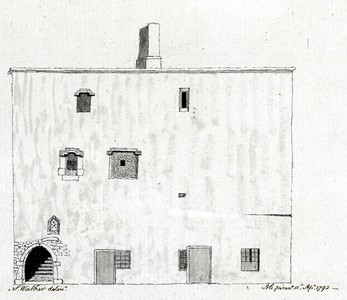Old Galway
Reconstruction of the Galway Fishery

by Tom Kenny
Based on the McMahon Report, a survey involving the engineers of the Commissioners of Public Works in consultation with local businessmen and anglers, works were undertaken to improve drainage, to facilitate navigation and to provide waterpower to the many mills in Galway. Waterpower was the bedrock on which the industry of Galway City was based and by the mid-19th century, there were some 30 mills in the city with associated headraces and tailraces which resulted in an intricate network of small waterways which greatly added to the charm of Galway.
The Lynch Window

by Tom Kenny
In 1807, the Reverend Edward Mangin wrote a 3-volume romantic novel entitled George the Third in which he headed one of the chapters “Which would not have appeared had it not been written”. In it he invented a story about the Mayor of Galway, James Lynch Fitzstephen, hanging his son. Thirteen years later James Hardman published his History of Galway in which he slightly changed, and greatly elaborated on the story.
ANCO, 50 years a-growing

by Tom Kenny
1967 saw a great change in Galway as the industrial estate was being developed as a result of the Government’s decision to designate Galway as a development location, a place which would be the commercial, financial, educational, health, social and administrative centre of the region. The IDA were buying land and building factories in anticipation of attracting industry to the county.
The Parochial School

by Tom Kenny
This is the time of the year when children are preparing to go back to school, a time when many of us would think back to our own schooldays, the happiest days of our lives. The issue of primary schooling in Ireland was contentious during the 17th-19th centuries because formal education was provided by Government only in association with Protestant Evangelical Societies and the Church of Ireland.
Street Festivals

by Tom Kenny
The first street festival held during the Quincentennial year of 1984 in Galway was organaised by High Street, Cross Street and Quay Street from the 23rd – 29 of April. It was opened by Mayor Michael Leahy with the Army Pipe band, St. Patrick’s Brass band, St. Patrick’s Boys Band, Renmore Brass band and the Dockers Fife and Drum Band all playing on the streets.
LIFESAVERS ALL

by Tom Kenny
Tuesday the 20th of November 1984 was a sad day in Galway, it was the day Jimmy Cranny died and though he had no family, his extended family of many thousands of people he had taught to swim mourned him and marked the passing of legend. He could be seen at the seashore virtually every evening of the summer for many many years teaching children the basics of swimming, and as some of them progressed to competitive swimming, he provided early morning training sessions for them at the canal on a daily basis.
150 YEARS RACING AT BALLYBRIT

by Tom Kenny
We know that horse races were organised in different parts of County Galway from the middle of the 18th century in places like Kilconnell, Eyrecourt, Rahasane, Ballinasloe, Ballymoe, Carraroe and Bermingham House near Tuam. They were known as ‘racing matches’. In 1764, there was a 5-day meeting held at Knockbarron near Loughrea and between 1829 and 1857, 15 meetings were held in Kiltulla near Ballybrut. In 1867, a series of races were organised at Bushfield near Oranmore.
FORTHILL CEMETERY, 1905

by Tom Kenny
It is often said that one cannot claim to be a true ‘old Galwegian’ or ‘auld shtock’ unless one has some relations buried in Forthill Cemetery at Lough Athalia. It is probably the oldest cemetery in Galway. The Augustinians have been associated with it since the year 1500. The Augustinian convent or priory was built there by Margaret Athy at the request of a friar, Richard Nagle and it probably stood on level ground at the upper level of Forthill. The grounds of the priory extended quite a bit along the shores of Lough Athalia, at least to the site where St. Augustine’s Well is today. Nothing at all remains of the priory except some drawings on the 1625 and 1651 maps.
.png)